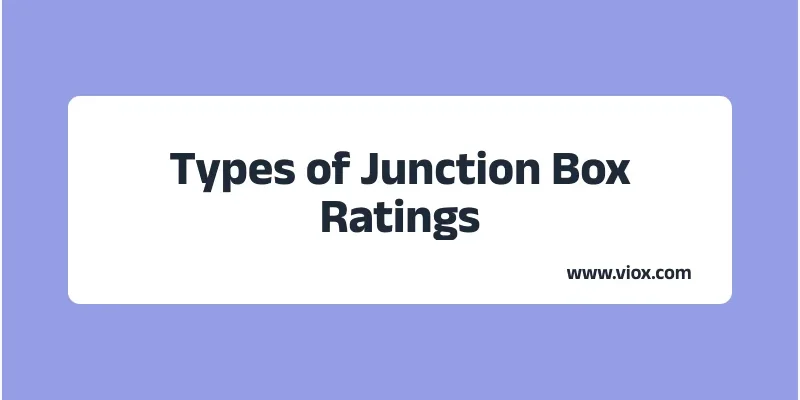Junction boxes are essential components in electrical systems, available with various ratings that determine their suitability for different environments and applications. These ratings, including NEMA, IP (Ingress Protection), and amperage, define the level of protection against environmental factors such as dust, water, and electrical current capacity.
Oversikt over NEMA-klassifiseringer
NEMA ratings utilize a numerical system ranging from 1 to 13, with additional letter designations like S, X, and R for special protection features. Unlike progressive systems, higher NEMA numbers don’t necessarily include features of lower ratings. Instead, each number represents resistance to specific environmental hazards. For example, NEMA Type 1 is suitable for indoor use and basic dust protection, while NEMA Type 3 and above are designed for outdoor applications with enhanced protection against various elements. This non-linear system allows for precise selection based on the specific requirements of the installation environment.
IP Ratings Explained
IP (Ingress Protection) ratings use a two-digit system to indicate protection against solids and liquids, providing a clear measure of a junction box’s resistance to environmental factors. Common IP ratings include:
- IP54: Limited dust protection and splash resistance
- IP65: Dust-tight and protected against water jets
- IP66: Dust-tight and protected against powerful water jets
- IP67: Dust-tight and protected against immersion up to 1 meter
- IP68: Dust-tight and protected against long-term immersion
The first digit represents protection against solid objects, while the second digit indicates liquid protection. This standardized system allows for easy comparison and selection of junction boxes based on specific environmental requirements, ensuring optimal performance and longevity in various applications.
NEMA vs IP Ratings
NEMA and IP ratings are two distinct systems used to classify junction box protection levels, each with its own strengths. NEMA ratings, primarily used in North America, cover a broader range of environmental factors including corrosion resistance and protection against atmospheric gases, while IP ratings, used internationally, focus solely on protection against solid objects and water ingress. While there’s no direct conversion between the two systems, they can be roughly compared. For example, NEMA 4X is often equated to IP66, offering protection against dust and powerful water jets.
Viktige forskjeller er blant annet
- NEMA ratings are self-certifying, while IP ratings require independent testing.
- NEMA standards include tests for icing conditions, which IP ratings do not address.
- IP ratings use a two-digit system for easy interpretation, while NEMA uses a non-linear numerical system with additional letter designations.
When selecting a junction box, consider the specific environmental challenges and regional standards to determine whether a NEMA or IP rated enclosure is more appropriate for your application.
UL Junction Box Ratings
UL (Underwriters Laboratories) ratings for junction boxes are crucial safety and quality standards specifically designed for enclosures containing high-voltage equipment and industrial control panels. Unlike NEMA and IP ratings, UL certification requires manufacturers to undergo independent testing by third-party evaluators to ensure compliance with their standards.
UL-listed junction boxes are rated numerically from 1 to 13, with some ratings including additional letter designations for enhanced protection. Key features of UL-rated junction boxes include:
- Construction from non-combustible materials such as metal or plastic.
- Corrosion-resistant materials like stainless steel or aluminum for metal boxes.
- Minimum volume requirements based on the number and size of conductors.
- Grounding requirements to prevent electrical shock and provide a path for fault current.
- Clear markings indicating hazardous location classifications and maximum temperature ratings, when applicable.
When selecting a junction box, look for “UL Listed” or “UL Recognized” labels to ensure compliance with these rigorous safety standards. UL-rated junction boxes are particularly important in hazardous locations, where they must be designed to prevent the escape of flammable gases or vapors and be grounded to prevent static electricity buildup.
Amperage Ratings and Uses
Electrical circuits require junction boxes rated for specific current capacities. Typically, 20 amp boxes are recommended for lighting circuits, while 30 amp boxes are used for ring mains and radial circuits. The amperage rating of a junction box should match or exceed the current rating of the circuit being connected to ensure safe and efficient operation. When selecting a junction box, it’s crucial to consider the total load of the connected devices and choose a box that can handle the maximum expected current flow without overheating or posing safety risks.
Protection Levels and Materials
For outdoor applications, junction boxes require a minimum rating of IPx4 to ensure protection against rain. Environments with floating dust necessitate at least an IP6x rating, while high-moisture settings like car washes demand a minimum IP05 protection level. Junction boxes are available in various materials to suit different needs, including metal (steel and aluminum), PVC plastic, and stainless steel for enhanced corrosion resistance. Each box comes with specific temperature ratings indicating its safe operating range, which is crucial for selecting the appropriate enclosure for the intended environment. When choosing a junction box, it’s essential to consider both the protection level required and the material best suited for the application to ensure optimal performance and longevity.
Selecting Appropriate Ratings
When selecting a junction box rating, consider the specific environmental conditions and application requirements. For outdoor installations, choose a minimum rating of IPx4 for rain protection, while environments with floating dust require at least an IP6x rating. In industrial settings, NEMA ratings are more common, with NEMA 4X offering protection against corrosion and water ingress.
Key factors to consider when choosing a junction box rating include:
- Explosion classification for hazardous environments.
- Material suitability for the intended application.
- Size and capacity to accommodate all wires and connections.
- Operating temperature range, especially for extreme conditions.
- Number of entry points or knockouts for wire management.
Always select a junction box with a rating that exceeds the circuit’s requirements to ensure safety and reliability. For specialized applications, consult industry-specific standards and regulations to determine the most appropriate rating for your needs.
Relatert
Forståelse av elektriske koblingsbokser
Forståelse av koblingsbokser: Viktige komponenter for sikre og effektive elektriske systemer


